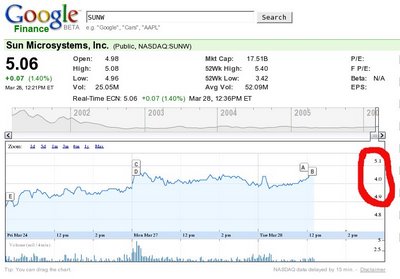When examining the three big Saas players, Ebay, Google and Salesforce.com, integral to their platform is the data platform and to some extend the unified user interface. Although offering their own application as software as a service was by original design, neither company started out as 'Let's be the Saas platform for other applications'. All three started out building an infrastructure around a single application and a key type of data: Ebay, the garage-sale data; Google with a catalog of the internet and Salesforce.com around CRM data.
Salesforce.com and AppExchange (http://www.salesforce.com - http://www.appexchange.com)
Customers use Salesforce.com for its CRM application. The data is securely stored in Salesforce.com datacenter. The database schemas and type of data are available to developers. This allows them to create helper applications to enhance the CRM application of Salesforce.com. To date, through AppExchange (the developer platform, formerly called Sforce), over 70 applications have been created and are listed on the AppExchange application directory. What makes this platform attractive to other developers is that the applications act upon the same data present in the (CRM) database. In addition, when a customer purchases a third party application, it is automatically integrated into the customer's salesforce.com portal. This provides for a great user experience. It also allows for even the smallest ISV to showcase their product as part of the big CRM application.
In December 2005, Salesforce.com launched their developer test ground, the Saleforce.com sandbox. Step one when using the sandbox, replicate some of your CRM data to work upon. The sandbox gives you an exact copy of your Salesforce deployment – including all your customizations and data – with a single click.
Google (http://www.google.com)
Google's mission is to organize the world's information and make it universally accessible and useful. With Google Base, Google goes one step further: Google will host your data. Google Base is a place where you can easily submit all types of online and offline content which Google will host and make searchable online. You can describe any item you post with attributes, which will help people find it when they search Google Base. In fact, based on the relevance of the items, they may also be included in the main Google search index and other Google products like Froogle and Google Local. Other ways to submit information to Google include Google Video, Google Print, Google Sitemaps, but also Gmail and Blogger. Google is hosting your data using the data platform which has been serving their crawlers and search engine for several years. Google is slicing and cataloging your data using those same crawlers. With Google Analytics, Google is offering website statistics to the end user and eventually the Saas developer. And then there is the rumored Google GDrive (referred to in slides at the Google Analyst Day) promise infinite storage.
With infinite storage, we can house all user files, including: emails, web history, pictures, bookmarks, etc and make it accessible from anywhere (any device, any platform, etc). We already have efforts in this direction in terms of GDrive, GDS, Lighthouse, but all of them face bandwidth and storage constraints today. For example: Firefox team is working on server side stored state but they want to store only URLs rather than complete web pages for storage reasons. This theme will help us make the client less important (thin client, thick server model) which suits our strength vis-a-vis Microsoft and is also of great value to the user. As we move toward the "Store 100%" reality, the online copy of your data will become your Golden Copy and your local-machine copy serves more like a cache. An important implication of this theme is that we can make your online copy more secure than it would be on your own machine. Another important implication of this theme is that storing 100% of a user's data makes each piece of data more valuable because it can be access across applications. For example: a user's Orkut profile has more value when it's accessible from Gmail (as addressbook), Lighthouse ...That's exactly it: each piece of data is more valuable as it can be used across various Google applications, as well as third party applications. The access to catalogued data is a very important factor developers will choose the Google APIs and for Google to partner with for Saas.
Similar arguments can be made for Ebay with over 100 applications it is Ebay solution directory already, using the same Ebay storefront user interface and accessing the same Ebay data.
Or Amazon Simple Storage Service (S3): tempting you to host your data with Amazon.
Or Windows Live (project Fremont).
The keys to the Saas kingdom will be in the hands of those who host the most data and have the scalable and secure data platform to support it.
Technorati:Saas google salesforce.com ebay

